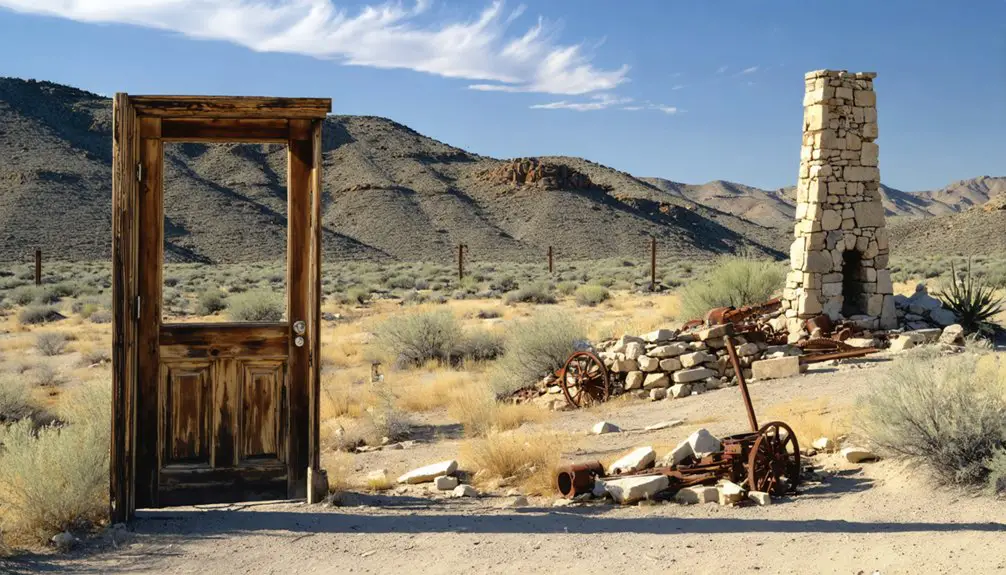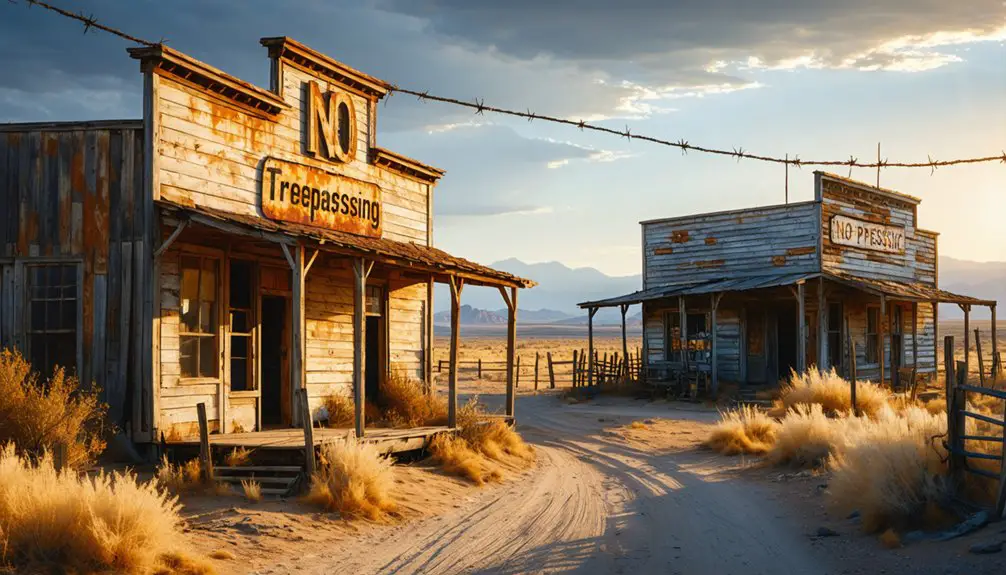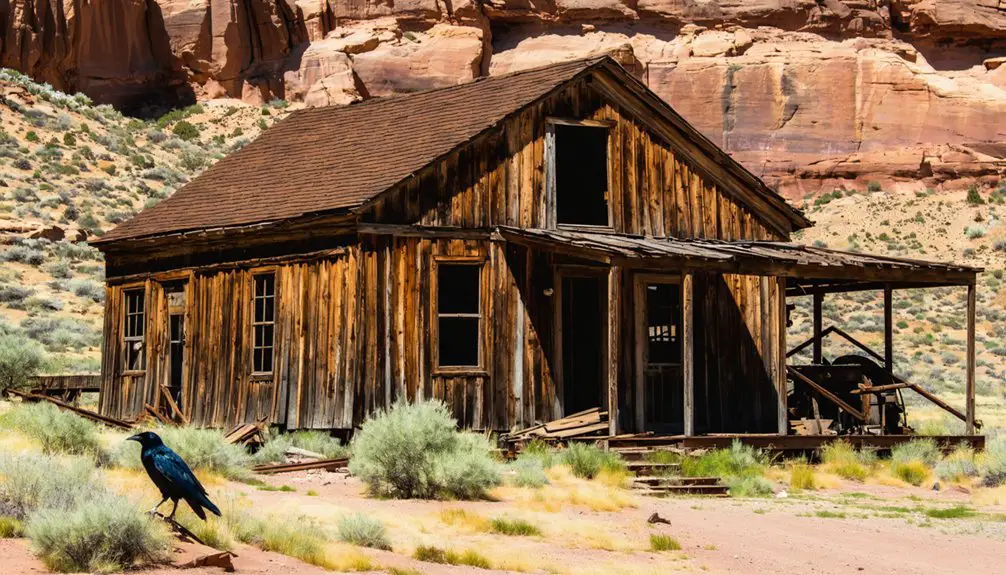You’ll find Heiner nestled in Carbon County, Utah’s historic coal mining region, where Frank Cameron’s 1911 coal discovery transformed the area into a bustling company town. At its peak in 1923, Heiner’s mines produced 700 tons of high-quality bituminous coal daily, supported by the Denver & Rio Grande Western Railroad. While only five buildings remain today, including the restored historic jail returned in 2017, the site’s rich mining heritage holds untold stories of Utah’s industrial past.
Key Takeaways
- Heiner was a coal mining company town in Carbon County, Utah, established in the late 19th century near Helper.
- The town thrived during the 1920s, producing 700 tons of coal daily and providing housing, electricity, and water for miners.
- Named after mine developer Moroni Heiner in 1918, the town featured a company store, school, and diverse immigrant workforce.
- Only five buildings remain from over 30 original structures, including an adobe schoolhouse and a recently returned historic jail.
- Abandonment resulted from resource depletion, economic decline, and infrastructure maintenance challenges in the isolated, mountainous location.
Location and Geographic Features
Located in Carbon County, Utah, Heiner sits near the town of Helper amid the rugged landscapes typical of eastern Utah’s coal mining region. The area operates on Mountain Daylight Time.
You’ll find the ghost town nestled within the Colorado Plateau‘s dramatic terrain, where steep canyons and mountainous features showcase the area’s geographic significance. At an elevation similar to nearby ghost towns like Mohrland (around 7,185 feet), Heiner’s position reflects the topographical features that drew mining operations to this resource-rich area.
The town’s setting near Cedar Creek Canyon and various red rock formations puts you in the heart of Utah’s historical mining district. Similar to the mysterious Utah monolith discovered at 4,300 feet elevation, Heiner’s location exemplifies the diverse topography of the region.
Nestled beside Cedar Creek Canyon’s crimson cliffs, Heiner stands as a testament to Utah’s rich mining heritage.
The surrounding semi-arid environment features stark elevation changes, while the region’s unique geology, particularly its coal seams, played a vital role in establishing settlements throughout Carbon County.
Early Settlement and Founding Years
During the late nineteenth century, Heiner emerged as one of Utah’s essential coal company towns, established amid Carbon County’s industrial expansion. Unlike traditional Utah settlements, you wouldn’t have found founding families establishing homesteads or agricultural plots. Instead, you’d have discovered a carefully planned company town where miners and their families rented homes for $6 to $25 monthly, typically $8 or $11.
The mining company shaped early community dynamics by providing essential infrastructure and services. You’d have benefited from electricity, running water, medical care, and schooling – amenities uncommon in rural Utah at the time. Similar to Iron City’s furnace, the town’s industrial facilities were central to its identity and economic purpose. Much like Utah’s first ghost town at Old Irontown, Heiner’s fate would be tied to industrial economics.
The company store served as the commercial hub, while traveling grocers supplemented residents’ needs. This structured environment helped create a stable workforce and fostered a distinct industrial community identity.
Mining Operations and Economic Growth
As Frank Cameron began prospecting coal in the Heiner area in 1911, he laid the foundation for what would become a thriving mining operation. Starting with just a 12-man crew producing 4 coal cars weekly, production expanded rapidly to 700 tons per day by 1923.
You’ll find that Cameron’s initial success sparked significant economic diversification in Heiner, with the establishment of company stores, schools, and a post office. The coal shared the same vein as the prominent Kenilworth and Castle Gate mines.
The mine’s high-quality bituminous coal attracted major players like United States Fuel Company, which took over operations in 1918.
Labor migration brought a diverse workforce to Heiner, where roughly 125 company houses supported the growing community. Situated at an elevation of 6,023 feet, the town provided an ideal location for mining operations.
The Denver & Rio Grande Western Railroad connection guaranteed efficient coal transport, cementing Heiner’s position as a crucial economic hub in Carbon and Emery counties.
Daily Life in Heiner’s Peak Years
In Heiner’s heyday, you’d find residents congregating at the company store, which served as both a commercial hub and social gathering spot for the mining community.
Your typical miner’s home came equipped with electricity and running water – modern amenities that weren’t yet common in rural Utah – while monthly rent payments ranged from $8 to $11 for most company-built houses. The mine’s workforce was notably diverse, with Third Wave immigrants from southeastern Europe, Mediterranean countries, and Asia making their home in the town. Similar to the Cosmopolitan Restaurant in other mining towns, local eateries became social centers for workers.
You could see the company’s influence on daily life through organized services like garbage collection, medical care, and education, plus their sponsorship of garden contests that encouraged residents to take pride in their yards.
Community Gathering Spots
While most mining towns boasted multiple entertainment venues, Heiner’s community life centered primarily around the company store and school, with limited dedicated social spaces.
You’d find residents gathering at the store for daily necessities, making it the town’s primary social hub alongside traveling grocers. The school served as another key meeting point, where families connected through their children’s activities and education. Unlike the town of Frisco which had 23 different saloons, Heiner maintained a more controlled social environment. Frisco’s reputation for violence resulted in 50 deaths daily from constant fighting.
The company encouraged community spirit through events like annual garden contests, though they preferred ornamental landscaping to vegetable gardens.
Unlike typical boom towns, you wouldn’t find saloons or theaters in Heiner. Instead, social interactions often occurred informally, particularly among the diverse immigrant populations who brought their cultural traditions to this company-controlled environment, where medical services and law enforcement facilities provided additional gathering opportunities.
Work and Living Conditions
During Heiner’s peak years, you’d find daily life revolving around the mining company’s extensive control of both work and housing arrangements.
You’d rent your home for $8 or $11 monthly, enjoying modern amenities like electricity and running water – luxuries rare in rural Utah then. While the company promoted community activities like garden contests, their control extended deep into daily economics.
You’d buy most necessities from their company store, though some supplies came from Helper or Price.
As one of 47 miners or in supporting roles like tipple work or carpentry, you’d find your family’s livelihood completely dependent on the company.
The workforce included immigrants, reflecting the region’s diversity, but economic dependency tightened as coal market changes and automation reduced available jobs in the late 1920s.
Notable Buildings and Infrastructure

As you explore Heiner’s remains today, you’ll find traces of company-built housing where miners and their families once lived in modest four-room homes renting for $8-25 monthly.
The town’s residential infrastructure included modern amenities like electricity and culinary water, making it more comfortable than many contemporary mining settlements.
While most structures have vanished, the railroad depot’s foundation serves as a reminder of Heiner’s essential connection to Utah’s coal transportation network.
Mining Company Housing Remains
The mining company housing in Heiner featured a diverse range of accommodations, from modest $6-per-month rentals to more substantial $25 monthly units equipped with electricity and running water.
Mining community dynamics were shaped by the company’s strict housing segregation policies, which divided residents by race in both family homes and boarding houses.
You’ll find evidence of the community’s pride in their yearly garden contests from 1928-1929, where residents prioritized ornamental landscaping over vegetable gardens.
The boarding houses played an essential role in supporting the transient workforce, including immigrants from across America and abroad.
This housing structure created a distinctly urban working-class atmosphere that set Heiner apart from Utah’s typically rural surroundings, while the company maintained control through centralized services like medical care and law enforcement.
Railroad Depot Foundation
Standing amid Heiner’s ghost town remnants, you’ll find an impressive railroad depot foundation that once served as a essential hub for the region’s coal transport and passenger services.
The depot architecture integrated stone and concrete materials, designed to withstand Utah’s harsh climate and support heavy rail traffic. You can still spot the raised platforms and drainage systems that showcase the foundation’s structural integrity.
This foundation represents more than just infrastructure – it was the backbone of Heiner’s economic impact and mining support.
Connected to major networks like Union Pacific, the depot played a critical connectivity role in Utah’s northward expansion.
The foundation’s robust construction, typical of late 19th-century urban development, helped establish Heiner as a significant point in the regional transportation network.
Factors Leading to Abandonment
Established around mining operations in Utah, Heiner’s fate mirrored many western boomtowns that couldn’t survive the harsh realities of resource depletion and economic volatility.
Like many of its neighbors, the town fell victim to the boom-and-bust economic cycles that dominated the region’s mining industry.
The harsh reality of mining economies left countless western towns like Heiner clinging to survival in cycles of prosperity and decline.
You’ll find that Heiner’s decline accelerated when its mines struggled to compete with larger operations. As mineral veins depleted and operations became less profitable, businesses shuttered and residents sought opportunities elsewhere.
The town’s isolation and challenging terrain made infrastructure maintenance costly, while social changes drew people toward growing urban centers.
When the railroad’s significance diminished, Heiner lost its crucial economic lifeline. Natural hazards, including floods and fires, dealt additional blows to the community, making recovery increasingly difficult for those who remained.
Remaining Structures and Artifacts

When you visit Heiner today, you’ll find only scattered foundations and crumbling walls marking where the once-bustling coal mining community stood.
The town’s most notable remaining structure is a partially intact stone building that served as the company store, though its roof has long since collapsed.
Mining equipment remnants, including rusted coal cart tracks and scattered metal machinery parts, still dot the landscape around the former mine entrances.
Standing Buildings Today
The once-bustling town of Heiner retains only five buildings from its original collection of more than 30 structures.
These remaining buildings face significant preservation challenges due to desert exposure and limited maintenance, showing typical deterioration patterns of abandoned frontier architecture.
Notable architectural styles and features you’ll find in Heiner include:
- The adobe schoolhouse stands as the most intact building, showcasing regional construction methods
- The historic jail, which returned to the area in 2017 after two relocations
- Wooden sidewalks and structural walls that reveal original town planning
- Thick stone and brick walls that enabled multiple building repurposing
- Original construction elements reflecting 19th-century frontier building practices, though many now exist as partial ruins
Mining Equipment Remnants
Rusting machinery and weathered industrial remnants scattered across Heiner’s mining complex tell a story of technological advancement in early Utah mineral extraction.
You’ll find conveyor belts with their gearing systems still visible among collapsed structures, showing how ore once moved through the site. The remains of massive ore processing equipment include sifter mechanisms, grinding wheels, and stamp mill components that crushed and separated valuable minerals.
Near the mine entrances, you can spot blower housing fragments from ventilation systems that once pumped fresh air underground.
Cyanide tanks with intact gear mechanisms reveal sophisticated chemical processing operations, while old boilers and steam engine parts demonstrate how power generation drove the mining machinery.
These industrial artifacts preserve Heiner’s legacy as a technologically progressive mining operation.
Historical Significance in Utah
Situated among Utah’s rich mining heritage, Heiner emerged as an essential coal-producing town that shaped the state’s industrial development throughout the early 20th century.
You’ll find this former mining hub’s cultural heritage deeply intertwined with immigrant contributions that transformed Utah’s social landscape during its peak years.
- Renamed in 1918 after mine developer Moroni Heiner, the town played a significant role in powering Utah’s residential and industrial growth.
- As part of Utah Fuel Company’s operations, Heiner connected to broader industrial networks across the region.
- The town’s multicultural population brought diverse traditions that enriched Utah’s mining communities.
- Archaeological discoveries have revealed insights into daily life, ethnic businesses, and social structures.
- Heiner’s legacy exemplifies the essential role of mining towns in Utah’s economic transformation during the industrial age.
Visiting Guidelines and Access

Modern-day visitors to Heiner should carefully plan their excursions, as access to this historic mining site follows specific guidelines to protect its remaining structures.
Like most Utah ghost towns, visitor etiquette emphasizes preservation and respect for both public and private property boundaries. You’ll find the site accessible during daylight hours, from dawn until dusk, with no overnight stays permitted.
The terrain offers relatively easy exploration along flat pathways, though you won’t find modern amenities or facilities on-site.
Park your vehicle in designated areas near the main structures, but remember that camping and RV stays aren’t allowed.
During summer visits, bring water and sun protection, as shade is limited.
Proper access hours observation and adherence to posted signs helps maintain this historic site for future generations.
Preservation Efforts and Status
While no dedicated preservation organization focuses solely on Heiner, the ghost town‘s most notable structure – the Daniel Heiner house – stands as a well-maintained symbol of Utah’s pioneer heritage.
Despite preservation challenges, the house retains excellent structural integrity, featuring its original two-story porch and distinctive slate blue stucco walls. Community involvement remains essential for protecting this pioneer-era landmark amid modern development pressures.
- Original architectural features include preserved railings and balustrades
- Updated asphalt shingles balance preservation with practical maintenance
- Mixed land use with modern construction surrounds historic structures
- Environmental factors require ongoing maintenance to prevent deterioration
- Missing ornamental details, like jig-saw scrollwork brackets, highlight restoration challenges
Frequently Asked Questions
Were Any Famous Outlaws or Notorious Criminals Known to Visit Heiner?
You won’t find documented outlaw sightings or criminal legends associated with this site. While western outlaws roamed Utah’s mining regions, historical records don’t indicate any notorious figures specifically visited here.
What Indigenous Tribes Originally Inhabited the Area Before Heiner’s Establishment?
You’ll find the Uintah Ute tribe originally dominated this region, with evidence of their indigenous history preserved through tribal artifacts. The Southern Paiute people also influenced nearby areas through trade and settlement.
Did Any Significant Paranormal Activities or Ghost Stories Originate From Heiner?
You won’t find documented ghost sightings or haunted locations in Heiner’s history. Unlike other Utah ghost towns, there aren’t any verified paranormal tales from this former coal mining community.
What Happened to the Cemetery and Burial Sites After Abandonment?
You’ll find deteriorating gravesites reclaimed by nature, with minimal grave preservation efforts after abandonment. Headstones crumbled, markers faded, and original burial rituals were forgotten as vegetation overtook the cemetery grounds.
Were There Any Major Epidemics or Disease Outbreaks in Heiner?
You won’t find records of major disease impact or epidemic history in this location. Available research suggests any health issues were typical mining-related concerns rather than widespread outbreaks.
References
- https://www.youtube.com/watch?v=xwju_iKuWu8
- https://parkcitylibrary.org/utah-ghost-towns/
- https://www.ksl.com/article/51308628/restored-utah-ghost-towns-that-should-be-on-your-summer-travel-bucket-list
- https://www.youtube.com/watch?v=eLGiwso6oZI
- https://lifeinutopia.com/utah-ghost-towns
- https://en.wikipedia.org/wiki/Mohrland
- https://www.youtube.com/watch?v=U63zicCAQIk
- https://www.mapquest.com/us/utah/heiner-ut-283371313
- https://www.latlong.net/place/herriman-ut-usa-22125.html
- https://en.wikipedia.org/wiki/Category:Ghost_towns_in_Utah



